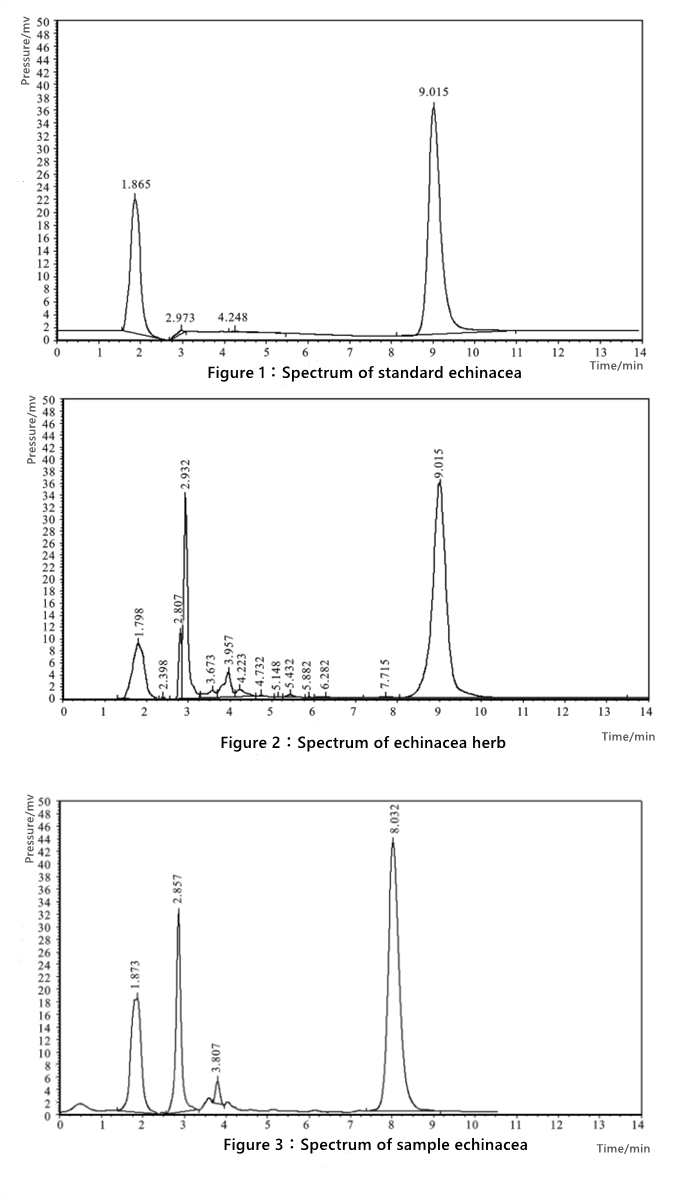Echinacea purpurea generally refers to Echinacea, a perennial herb. The active components of echinacea include polyphenols, caffeic acid derivatives, polysaccharides, alkylamide, volatile oil and so on. Chicory acid is the most extracted component of echinacea, it has anti-inflammatory, antioxidant and immune-enhancing effects, inhibits hyaluronidase, protects collagen from degrading free radicals, and also inhibits HIV-1 and HIV-1 integrase. The molecular formula of Chicoric Acid is C22H18O12, and the molecular structure is shown below.
There are currently two ways to produce chicory acid, one from natural plants such as dandelion, chicory and echinacea, and the other through chemical synthesis. Synthetic chicory acid can be toxic, complicated and low in yield, while echinacea is the raw material for extracting chicoric acid from natural plants. The extraction methods of Chicoric Acid from Echinacea are methanol, ethanol, water and supercritical fluid extraction. Methanol extraction is easy to causes organic solvent residue, which affects product quality and brings unsafe factors. The oxidation of chicory acid was easily caused by high water extraction temperature. Supercritical extraction has a high cost and low yield. Therefore, ethanol is used as an extraction solvent, which is cheap and safe to operate.
Chicoric acid is a type of commonly used Polyphenolic acids, and has been found in 63 species and genera like chicory, dandelion, and purple coneflower. These plant parts contain high amounts of chicoric acid and are thus an excellent source of this antioxidant. To extract Chicoric Acid, researchers must first isolate its constituents from plant materials. The extraction of the compounds is time-consuming and labor-intensive. Moreover, little research has been conducted on how to optimize sample extraction for specific plants and structures, or for multiple target compounds. The review summarizes the findings of recent research and discusses a new biosynthesis of chicoric acid: Spray Extraction.
Spray extraction is a kind of continuous spray extraction method to achieve the separation of plant active components, with high solvent efficiency, simplified process, high extract content. In this paper, ethanol was used as the extraction solvent, spray extraction was used as the extraction method, and different concentration gradients were set to study the influence of chicory acid extraction. At the same time, the influence of the amount of feed and spray pressure on the data was evaluated, and the content of chicory acid was determined by high performance liquid chromatography to obtain the content of chicory acid, and the recovery was calculated.
Materials and Instruments
Plant material: Echinacea whole herb
Main equipment: SPD-10AVP high performance liquid chromatography, SENCO R series rotary evaporator, SHB – ⅲ A circulating water vacuum pump, SP-22/26 high pressure power spray plunger pump, etc.
The Experimental Method
Orthogonal experiment. Ethanol concentration (A), feed volume (B) and spray pressure (C) were selected as three factors, and 60% ethanol, 70% ethanol and 80% ethanol were used respectively. 2 times the amount of feed, 4 times the amount of feed, 6 times the amount of feed and 10 kg spray pressure, 15 kg spray pressure, 20 kg spray pressure are the three levels of the three factors, orthogonal test L9, with recovery as the index, determine the best extraction process.
Chicory acid spray extraction of orthogonal experiment:
| Item | Ethanol concentration(A) | Feed volume(B) | Spray pressure(C) | Recovery |
| Test 1 | 1 | 1 | 1 | 83.56% |
| Test 2 | 1 | 2 | 2 | 85.80% |
| Test 3 | 1 | 3 | 3 | 86.17% |
| Test 4 | 2 | 1 | 2 | 88.83% |
| Test 5 | 2 | 2 | 3 | 99% |
| Test 6 | 2 | 3 | 1 | 88.56% |
| Test 7 | 3 | 1 | 3 | 82.98% |
Spray extraction of Chicoric Acid. According to the conditions listed in the orthogonal experiment table, 100 g of echinacea powder was respectively added with 800 mL of ethanol at the specified concentration to stir and dissolve. A certain amount of ethanol at the same concentration was used for feeding. The high-pressure dynamic spray plunger pump was powered on and sprayed for 3 min, during which each nozzle and nozzle were extended under the page and not close to the bottom of the cup. Turn off the spray switch and then turn off the power. Open the circulating water vacuum pump, pour the spray extract into the extraction funnel for extraction and filtration, concentrate, dry, bag, detect the extract through high-performance liquid chromatography, get the content and calculate the recovery rate. The calculation formula is as follows:
Content of herb materials = (Peak area of medicinal materials × concentration of standard materials) /(Standard area × concentration of medicinal materials) × content of standard materials × 100%;
Sample content = (Sample peak area × sample concentration) /(standard peak area × sample concentration) × standard content × 100%;
Recovery rate of chicory acid = (Sample quantity × sample content) /(consumption of medicinal materials × content of medicinal materials) × 100%;
Determination of Chicory Acid Content
The content of Chicoric Acid was determined by HPLC.
Chromatographic conditions: Column Ultimate XB-C18 (4. 6× 150 mm, 5 μm); Mobile phase acetonitrile: 0. 1% phosphoric acid solution (25:75); Velocity of 0. 8 ml, min – 1; Column temperature 30 ℃; The detection wavelength was 330 nm; Injection volume 20 μL.
Preparation of standard solution: Weigh accurately the standard chicory acid 5mg and place it in a 50 mL volumetric flask, dissolve it in 70% methanol and keep the volume to the scale, shake well, dilute 1 mL with 70% methanol to 10mL, shake well, and set aside.
Preparation of sample solution: Weigh accurately the sample powder 10mg and place it in a 25 mL volumetric flask, dissolve it in 70% methanol and keep the volume to the scale, shake well and wait for testing.
Determination of herbal: Precision weighing 0. 20 g of echinacea was placed in a corkscrew conical flask, and 100 mL of 70% methanol was added for ultrasonic treatment for 1 H. After cooling, the herb was filtered to a constant volume of 100 mL volumetric flask, and then shook well. Determination was performed according to the above chromatographic conditions.
According to the range analysis, we can conclude that ethanol concentration has the greatest influence on the recovery of Chicoric Acid and the spray pressure is the lowest, among which 70% ethanol concentration is the best. However, considering the cost, the optimal extraction process combination was determined as A2B2C3 under the premise of ensuring the extraction efficiency, that is, 70% ethanol was used as the extraction solution, the extraction amount was 4 times of the echinacea powder used, and the spray pressure was 20 kg.
Determination of Chicoric Acid by HPLC
The detection spectrum of echinacea standard was shown in Figure 1. The detection peak of solvent first appeared before the 8th minute, followed by the detection peak of impurities. The main peak, i.e. the detection peak of chicory acid, did not appear until the 9th minute. The main peak also appeared at the 9th minute in Fig.2. The main peak also appeared at the 8th minute in Fig.3. According to the solution configuration before detection, the standard concentration is 0. 01mg· mL-1, the sample concentration is 0. 4 mg· mL-1, the concentration of medicinal materials was 2 mg· mL-1. Peak area of standard product is 759 675. 188, the peak area of medicinal materials was 898 783. The sample peak area is 1 023 235. 967, calculated by Formula 1 and Formula 2:
Crude material content = (898 783. 000 x 0. 01 mg · mL-1) /(759 675. 188 × 2 mg· mL-1) × 98% ×100% = 0. 60%
The sample quantity obtained through the experimental process is 16. 18 g, the recovery rate of chicory acid was calculated: (16. 18 g × 3. 30%) /(100 g × 0. 60%) × 100% =88. 99%
Chicoric Acid is a heat-sensitive compound, the extraction of Chicoric Acid Powder by spray method can reduce damage, simple operation, convenient, safe, low cost, more suitable for industrial production. According to the current experimental studies, echinacea extract needs to be further standardized for its active ingredients in order to make more rational use. The current lack of a rapid method to assess chicoric acid in purple coneflower roots warrants the development of a new analytical method that can measure the concentration of this phytochemical with great accuracy.
- Dandelion Extract: What It Is, Benefits, Uses and Side Effect - April 23, 2024
- Is Berberine Extract Help For Weight Loss? - April 11, 2024
- Why Is Pysllium Husk Powder A Popular Meal Replacement Ingredient? - April 3, 2024



